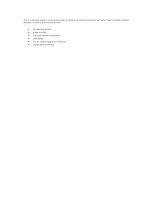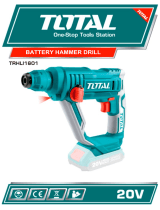Grounded Tools: T
ools with Three Prong Plugs
Tools marked “Grounding Required” have a three
wire cord and three prong grounding plug. The
plug must be connected to a properly grounded
outlet (See Figure A). If the tool should electrically
malfunction or break down, grounding provides a
low resistance path to carry electricity away from
the user, reducing the risk of electric shock.
The grounding prong in the plug is connected
through the green wire inside the cord to the
grounding system in the tool. The green wire in the
cord must be the only wire connected to the tool's
grounding system and must never be attached to
an electrically “live” terminal.
Your tool must be plugged into an
appropriate outlet, properly installed
and grounded in accordance with
all codes and ordinances. The plug
and outlet should look like those in
Figure A.
Double Insulated Tools:
Tools with Two Prong Plugs
Tools marked “Double Insulated” do not require
grounding. They have a special double insulation
system which satisfi es OSHA requirements and
complies with the applicable standards of Underwrit-
ers Laboratories, Inc., the Cana-
dian Standard Association and the
National Electrical Code. Double
Insulated tools may be used in ei-
ther of the 120 volt outlets shown in
Figures B and C.
Fig. B
Fig. C
Fig. A
GROUNDING
WARNING Improperly connecting the
grounding wire can result in the risk of elec-
tric shock. Check with a qualifi ed electrician
if you are in doubt as to whether the outlet is
properly grounded. Do not modify the plug
provided with the tool. Never remove the
grounding prong from the plug. Do not use
the tool if the cord or plug is damaged. If
damaged, have it repaired by a MILWAUKEE
service facility before use. If the plug will not
fi t the outlet, have a proper outlet installed by
a qualifi ed electrician.
Grounded tools require a three wire extension
cord. Double insulated tools can use either a two
or three wire extension cord. As the distance from
the supply outlet increases, you must use a heavier
gauge extension cord. Using extension cords with
inadequately sized wire causes a serious drop in
voltage, resulting in loss of power and possible tool
damage. Refer to the table shown to determine the
required minimum wire size.
The smaller the gauge number of the wire, the
greater the capacity of the cord. For example, a 14
gauge cord can carry a higher current than a 16
gauge cord. When using more than one extension
cord to make up the total length, be sure each cord
contains at least the minimum wire size required.
If you are using one extension cord for more than
one tool, add the nameplate amperes and use the
sum to determine the required minimum wire size.
Guidelines for Using Extension Cords
• If you are using an extension cord outdoors, be
sure it is marked with the suffi x “W-A” (“W” in Cana-
da) to indicate that it is acceptable for outdoor use.
• Be sure your extension cord is properly wired
and in good electrical condition. Always replace a
damaged extension cord or have it repaired by a
qualifi ed person before using it.
• Protect your extension cords from sharp objects,
excessive heat and damp or wet areas.
READ AND SAVE ALL
INSTRUCTIONS FOR FUTURE USE.
* Based on limiting the line voltage drop to fi ve volts at
150% of the rated amperes.
EXTENSION CORDS
Recommended Minimum Wire Gauge
For Extension Cords*
Extension Cord Length
Nameplate
Amperes
25' 50' 75' 100' 150'
0 - 2.0
2.1 - 3.4
3.5 - 5.0
5.1 - 7.0
7.1 - 12.0
12.1 - 16.0
16.1 - 20.0
18
18
18
18
16
14
12
18
18
18
16
14
12
10
18
18
16
14
12
10
--
18
16
14
12
10
--
--
16
14
12
12
--
--
--
Inserting Drill Bit or Chisel
NOTE: Only use accessories with SDS shanks.
1. Insert the bit or chisel into the nose of the tool.
2. Rotate bit slowly until it aligns with the locking
mechanism.
3. Push bit into tool until it locks.
4. Check that the bit is locked properly; it should
be possible to pull the bit back and forth slightly
(about 1/4").
5. To remove bits and chisels,
pull bit holder release collar
toward the rear of tool and
remove bit.
NOTE: Use caution when
handling hot bits and
chisels.
WARNING To reduce the risk of injury,
always use a side handle when using this tool.
Always brace or hold securely.
ASSEMBLY
OPERATION
WARNING To reduce the risk of injury,
always unplug tool before attaching or remov-
ing accessories or making adjustments. Use
only specifi cally recommended accessories.
Others may be hazardous.
WARNING To reduce the risk of injury,
keep hands and cord away from the bit and
all moving parts.
WARNING To reduce the risk of injury,
wear safety goggles or glasses with side shields.
Drilling
Depth
Bit holder
release collar
Selecting Action
MILWAUKEE Rotary Hammers have three settings:
drill only, rotary hammer, and hammer only.
1. For drilling, turn the selec-
tor lever so the arrow on
the lever points to the twist
drill symbol.
2. For rotary hammering, turn
the selector lever so the ar-
row points to the hammer
and twist drill symbol.
3. For hammering only, turn
the selector lever so the
arrow points to the hammer symbol.
4. To freely rotate the bit to the desired angle for
hammering only, turn the selector lever to the
O
symbol. Then, follow step 3.
NOTE: To engage the hammering mechanism,
maintain pressure on the bit. When pressure on the
bit is released, the hammering action will stop.
Starting, Stopping & Controlling Speed
1. To start the tool, pull trigger.
2. To stop the tool, release trigger.
3. To vary the speed, increase or decrease pres-
sure applied to trigger.
Operating
Position the tool, grasp the handles fi rmly and pull
the trigger. Always hold the tool securely using both
handles to maintain control. This tool has been
designed to achieve top performance with only
moderate pressure. Let the tool do the work.
If the speed begins to drop off when drilling large
or deep holes, pull the bit partially out of the
hole while the tool is running to help clear dust.
Do not use water to settle the dust since it will
clog the bit fl utes and tend to make the bit bind
in the hole. If the bit should bind, a built-in, non-
adjustable slip clutch prevents the bit from turn-
ing. If this occurs, stop the tool, free the bit and
begin again.
Adjusting the Side Handle Position
1. Loosen the clamping screw slightly.
2. Pull the side handle forward and turn it to the
required angle.
3. Fit the side handle into the nonslip mounting until
it adjusts into place and retighten the clamping
screw.
Setting the Depth Gauge
1. Loosen the clamping screw.
2. Slide the depth gauge rod backward or forward
until it is set for the desired depth.
NOTE: The drilling
depth is the distance
between the tip of the
bit and the tip of the
depth gauge rod.
3. Tighten the clamping screw securely.
WARNING To reduce the risk of injury,
always unplug tool before attaching or remov-
ing accessories or making adjustments. Use
only specifi cally recommended accessories.
Others may be hazardous.
















